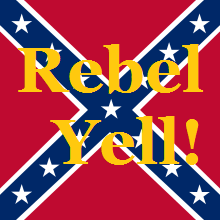The Rebel Yell – What did it sound like?
It’s been over 150 years since the Civil War ended, and the Rebel Yell is always a curious topic of conversation. No one really knows what it sounded like, since there are no audio recordings of actual battles. But it’s the stuff legends are made of, living on in one’s imagination.
Some Confederate veterans have reported that yell sounded like a “rabbit’s scream.” Historian Shelby Foote, from Ken Burns Civil War Series, said it was described as “a foxhunt yip mixed up with sort of a banshee squall.”
Foote tells about an old Confederate veteran invited to speak at a ladies’ society dinner. When asked for a demonstration of the rebel yell, he refused on the grounds that it could only be done “at a run.” And he said he couldn’t do it anyway with “a mouth full of false teeth and a stomach full of food”.
No one knows the real origin of the yell, either. Some say it may have been taken from Native American war cries as many had sided with the South in the war. Others claim it may have come from Scottish or Celtic traditional battle cries.
The closest we may come to knowing what it really sounded like is from 90 year old Thomas Alexander, a veteran of the 37th North Carolina Regiment 1935 present at a meeting of the Sons of Confederate Veterans. He was asked to deliver his rendition of the Rebel Battle Cry to a local radio station. It sounded like a “wa-woo-woohoo” repeated several times. Based on that recording, many re-enactment groups have adopted it and include it in their demonstrations.
We may not know exactly what the rebel yell sounded like or where it came from, but we do know why the fighting soldiers used it. It was a “bone chilling, mortifying, hair raising sound” designed to put fear into the hearts of the enemy so he will surrender or flee. It also worked to boost the morale of the fighting men or even embolden them as they charged.
One of the earliest accounts of the yell comes from the First Battle of Manassas (Bull Run) during the assault at Henry House Hill. Stonewall Jackson ordered the men to “yell like furies” during a bayonet charge. It must have worked because the Federal forces were pushed back to Washington D.C.
Union soldiers reportedly said, “if you claim you heard it and weren’t scared that means you never heard it.” Someone described it as “a peculiar corkscrew sensation that went up your spine when you heard it.”
One Confederate soldier explained: “I always said if I ever went into a charge, I wouldn’t holler! But the very first time I fired off my gun I hollered as loud as I could and I hollered every breath till we stopped.”
General Jubal Early once told troops who hesitated to charge because they were out of ammunition: “Damn it, holler them across!”
Colonel Keller Anderson of Kentucky’s Orphan Brigade (the First Kentucky Brigade) wrote:
“Then arose that do-or-die expression, that maniacal maelstrom of sound; that penetrating, rasping, shrieking, blood-curdling noise that could be heard for miles and whose volume reached the heavens–such an expression as never yet came from the throats of sane men, but from men whom the seething blast of an imaginary hell would not check while the sound lasted.”
Almost makes you wish you were there to hear it doesn’t it?

